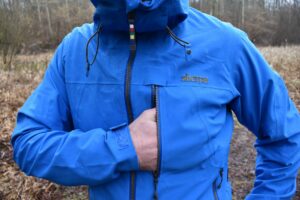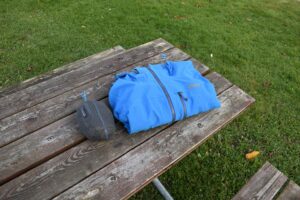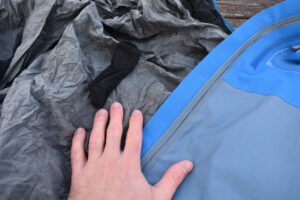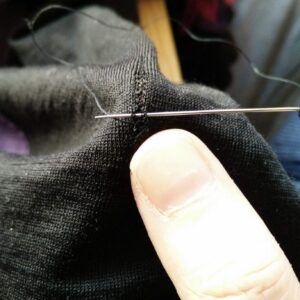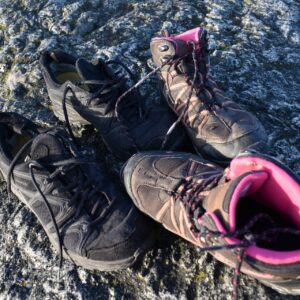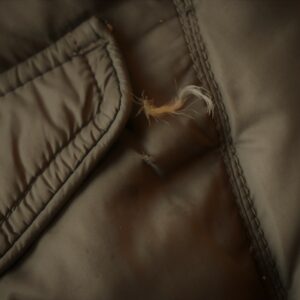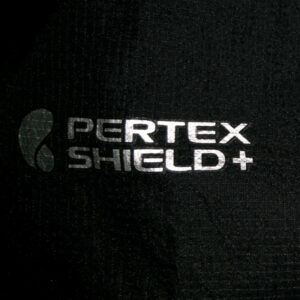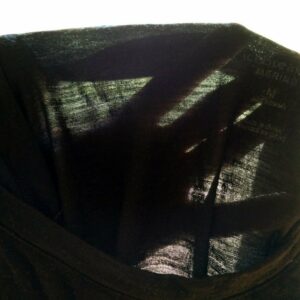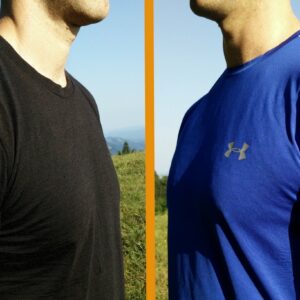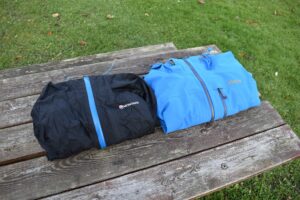
2.5-Layer VS. 3-Layer Rain Jackets: Left Montane Minimus 2.5L jacket and right Sherpa Makalu 3L jacket
Rain jackets differ by layering construction and before purchasing a new rain jacket you should definitely check which layering construction it utilizes. Why? Well, the thing is that there is a big difference between 2.5-layer and 3-layer rain jackets in terms of weight, protection against the elements, durability packability and price. Both types of jackets can provide superb performance, but each type has its own advantages and disadvantages. I own both a 3-layer rain jacket (Sherpa Makalu) and a 2.5-layer rain jacket (Montane Minimus), and before each hike I undertake, I decide which one to wear or take with me after checking the weather forecast. In the following I’ll explain the differences between 2.5-layer and 3-layer rain jackets to help you choose the right hardshell for your needs and type of activity.
If you are not sure which layering construction a given rain jacket utilizes, check out the product on the manufacturer’s website. The layering construction is typically mentioned in the materials section. In most cases, it’s written something like “2.5L Pertex Shield” or “3L Gore-Tex Pro” where L stands for layer.
Table of contents:
- Durability and price
- Weight and packability
- Protection against the elements
- Air permeability
- Conclusion
Durability and price
3-layer rain jackets provide much better durability than 2.5-layer jackets because they are made of thicker and more robust fabrics. A 3-layer jacket consists of a liner on the inside, membrane in the middle and face fabric on the outside. A 2.5-layer rain jackets doesn’t have a liner on the inside but utilize a protective film or print instead. That’s the “half” layer, and the main difference between 2.5-layer and 3-layer rain jackets. This protective film is usually very thin and thin fabrics tend to get damaged faster than thick fabrics. For example, my Montane Minimus 2.5L jacket is so thin that I don’t dare to put my keys or anything seemingly sharp into the pockets because I’m worried that it’ll damage the fabric. I also don’t wash the jacket in the washing machine because I think that the fabric is simply too delicate. So, in terms of durability, 3-layer rain jackets indeed provide much better performance. Therefore, they are a great option for ice climbing, hardcore mountaineering, alpinism and other activities that require sturdy outer layers.
However, 2.5-layer rain jacket are significantly less expensive. They typically cost less than $200 and can be as cheap as $100 if they utilize a coating instead of a membrane. Coatings provide inferior rain protection and air permeability (breathability) but are cheaper to manufacture and apply. The prices for low-end 3-layer rain jackets start at $200 but top-tier products can cost as much as $500 +.
Weight and packability
In the section above, I mentioned that 3-layer rain jackets are made of relatively thick fabrics. Thick fabrics are heavier than thin fabrics and thus it’s no surprise that 3-layer rain jackets are generally heavier than 2.5-layer rain jackets. 2.5-layer rain jackets weigh less than 10 ounces (300 g) in most cases with some top-tier products being as light as 6 oz (180 g). An example of such a product is the Outdoor Research Helium jacket which is one of the lightest rain jackets on the market. Superlight 3-layer rain jackets weigh between 10 ounces (300 g) and 14 ounces (400 g). However, most 3-layer rain jackets are heavier and weigh 17 ounces (500 g) or more.
2.5-layer rain jacket are not only lighter, but they also pack smaller. They typically come with a pouch or can be stowed into one of jacket’s pockets. So, in terms of weight and packability 2.5-layer rain jackets for sure provide better performance. Therefore, they are a great option for adventures where you plan to bring a rain jacket as a backup in case of bad weather, such as a fast alpine ascent or a long backpacking trip in predominately good weather with a small chance of rain. In such cases, it doesn’t make sense to wear or pack a heavy and bulky rain jacket because you’ll be anyway carrying it in the backpack for most of the time. To learn why it’s important to pack lightweight, read my article Why hike lightweight where I explain the effect of backpack weight on heart rate.
Protection against the elements
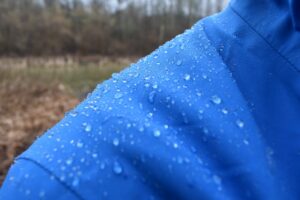
3-layer rain jackets provide better waterproofness and are more comfortable to wear in very windy conditions
3-layer jackets provide better water resistance than 2.5-layer rain jackets. The waterproofness of a fabric is measured in hydrostatic head and some 2.5-layer rain jackets do match 3-layer rain jacket in this metric. For example, my Montane Minimus 2.5-layer rain jacket has a hydrostatic head of 20.000 mm which is the same as the hydrostatic head of my Sherpa Makalu 3-layer jacket. So, in theory these two jackets should provide the same level of waterproofness. However, in practice the Makalu jacket provides better waterproofness. Furthermore, it also doesn’t get as clammy on the inside as the Minimus jacket because it’s made of thicker fabric and has a liner on the inside. 2.5-layer rain jacket usually get clammy fast because they don’t have a liner on the inside.
There is no difference in terms of wind resistance between the two types of jackets. In my experience, both efficiently block wind gusts. However, I do find 3-layer jackets more comfortable to wear in windy conditions. They are made of heavier materials and thus the fabric is less affected by wind gusts, whereas I feel like I’m wearing a fluttering plastic bag when I wear a 2.5-layer rain jacket in strong winds.
Air permeability
Many online resources state that 3-layer rain jackets provide better breathability than 2.5-layer rain jackets. However, in my experience both jacket types can be equally breathable. Air permeability (more often referred to as breathability) is measured with MVTR, and 3-layer rain jacket typically have MVTR values of 20.000 g/m2/24h or more. 2.5-layer rain jackets normally have MVTR between 10.000 and 20.000 g/m2/24h. I haven’t experienced a big difference in felt breathability between a 3-layer rain jacket with MVTR of 20.000 and a 2.5-layer rain jacket with the same MVTR. The only thing I noticed is that the 2.5-layer rain jacket gets clammier during intense activities because it has no liner which would absorb some of the moisture. So, in terms of breathability, the MVTR value is more important than the type of the jacket. It’s, however, true that MVTR ratings of top-tier 3-layer rain jackets typically exceed MVTR ratings of top-tier 2-5-layer rain jackets.
Conclusion
So, should you buy a 2.5-layer rain jacket or a 3-layer rain jacket? If you are on a tight budget, a 2.5-layer rain jacket is the obvious choice. A 2.5-layer rain jacket is also a better option if you mostly hike in dry weather with only a small chance of rain, so that the (packed) hardshell is meant as a backup rather than for wearing a whole day.
For all other scenarios a 3-layer rain jacket is a better choice. 3-layer rain jackets provide better durability and weather protection. They are perfect for activities where you wear the hardshell nonstop like mountaineering in wet snow, alpinism, ice climbing etc.
I’d love to hear about your thoughts on 2.5- and 3-layer rain jackets. Write them in the comments section below.
